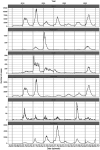Spatial-temporal distribution of chikungunya virus in Brazil: a review on the circulating viral genotypes and Aedes (Stegomyia) albopictus as a potential vector
- PMID: 39722706
- PMCID: PMC11668782
- DOI: 10.3389/fpubh.2024.1496021
Spatial-temporal distribution of chikungunya virus in Brazil: a review on the circulating viral genotypes and Aedes (Stegomyia) albopictus as a potential vector
Abstract
Chikungunya virus (CHIKV) is mainly transmitted by the invasive mosquito Aedes (Stegomyia) aegypti in tropical and subtropical regions worldwide. However, genetic adaptations of the virus to the peri domestic mosquito vector Aedes (Stegomyia) albopictus has resulted in enhanced vector competence and associated epidemics and may contribute to further geographic expansion of CHIKV. However, evidence-based data on the relative role of Ae. albopictus in CHIKV transmission dynamics are scarce, especially in regions where Ae. aegypti is the main vector, such as in Brazil. Here, we review the CHIKV genotypes circulating in Brazil, spatial and temporal distribution of Chikungunya cases in Brazil, and susceptibility to infection and transmission (i.e., vector competence) of Ae. albopictus for CHIKV to better understand its relative contribution to the virus transmission dynamics.
Keywords: Aedes albopictus; chikungunya; environmental/ecological determinants; vector competence; virus diversity and genotypes.
Copyright © 2024 Resck, Câmara, dos Santos, dos Santos, Alto and Honório.
Conflict of interest statement
The authors declare that the research was conducted in the absence of any commercial or financial relationships that could be construed as a potential conflict of interest.
Figures


References
-
- WHO . Chikungunya. (2022). Available at: https://www.who.int/news-room/fact-sheets/detail/chikungunya. (Accessed December 2, 2024).
Publication types
MeSH terms
LinkOut - more resources
Full Text Sources
Medical

